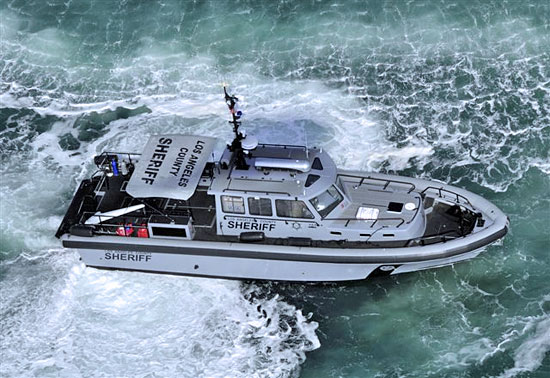A boatload of homeland security
January 10, 2012

Sheriff's officials are hoping to soon have a second terrorist-fighting boat patroling the waters off L.A. County.
Its crews have secured evidence from offshore pot busts. Its advanced sonar helped locate wreckage from a mid-air plane crash off the coast three years ago.
But mostly the Ocean Rescue II spends its days scanning for a threat that its crew hopes will never appear on any law enforcement blotter: the possibility that weapons of mass destruction might be smuggled into the massive Port of Los Angeles.
“This boat essentially provides homeland security for the entire L.A.County coast,” says Los Angeles County Sheriff’s Lt. Jack Ewell, who has worked on the 55-foot-long, super-high-tech vessel since its deployment in the port three years ago.
Paid for with a $2.25 million federal grant from the Department of Homeland Security and operated by a rotating 3-man crew from the sheriff’s special enforcement bureau, the Ocean Rescue II can scan ship hulls for traces of biological, radiological, chemical and nuclear weapons and can transmit the data to onshore labs in real time. Its sonar sees threats in the murkiest waters; its remote underwater vehicle can pluck bombs from ship bottoms and retrieve evidence 3,000 feet underwater.
“It’s pretty unique,” says David Gutierrez, vice-president of manufacturing at Willard Marine in Anaheim, which custom-built the vessel for the Sheriff’s Department. “It looks like just a standard boat with a lot of bells and whistles, but it’s a very important piece of equipment at the port.”
But the combination of all that technology and salt air is an ongoing issue: “You have to keep it painted, maintain the engines—to keep a boat like that working 7 days a week requires a lot of maintenance,” Ewell says.
“It’s like a patrol car,” agrees Gutierrez. “It has to always be ready to go.”
This, Ewell says, is why the sheriff hopes to bring in a backup with the help of a $3 million federal grant won by the department last year.
“A second boat will give us the capability to rotate vessels, or to have two boats in the water at the same time,” Ewell says.
It also will add to the sheriff’s already impressive counter-terrorism arsenal, which includes a radiation-detecting helicopter and a biological- and chemical-weapon-sniffing Labrador named Johnny Ringo.
At least eight of the 34 boats in the sheriff’s department fleet are assigned to the Special Enforcement Bureau, which includes the Homeland Security Division where Ewell works. Another dozen—including an offshore vessel with nuclear detection capabilities—patrol out of Marina del Rey or Catalina Island.
Backing them up, of course, are maritime forces from the U.S. Coast Guard as well as port-stationed boats manned by the Long Beach police, the Port of Los Angeles police and other law enforcement agencies.
The stakes are high, Ewell explains.
“It’s been estimated that an incident that shut down the port here would cost theU.S.economy $2 billion a day,” he says. “Forty percent of the nation’s imports come through here, and our coastal region is heavily populated. It would devastate the region if anything were to affect the port.”
So far, Ewell says, the boat’s daily scanning hasn’t uncovered any dirty bombs. (“Believe me, you’d know it if they did.”)
But it has been put to other uses. In April 2010, for instance, the sheriff’s department used it to help secure a large cache of marijuana from an isolated cove on Catalina Island where a smuggler’s boat had been stranded.
And in 2009, when two private planes collided in mid-air off the coast of Long Beach, Ewell says, “the boat was used for two weeks straight to recover parts of the planes, and to find the victims and return the remains to their families.”
The second boat, if authorized next week by the Board of Supervisors, would similarly do double duty, Ewell says. Like Ocean Rescue II, it is expected to be equipped with advanced life support equipment, and to be set up for large-scale diver operations.
“We’ll use it on medical emergencies, criminal investigations, plane crashes,” he says. “The way budgets are these days, you have to get a lot of bang from the buck.”
Posted 1/10/12












 405 bridge work causes a stink
405 bridge work causes a stink
